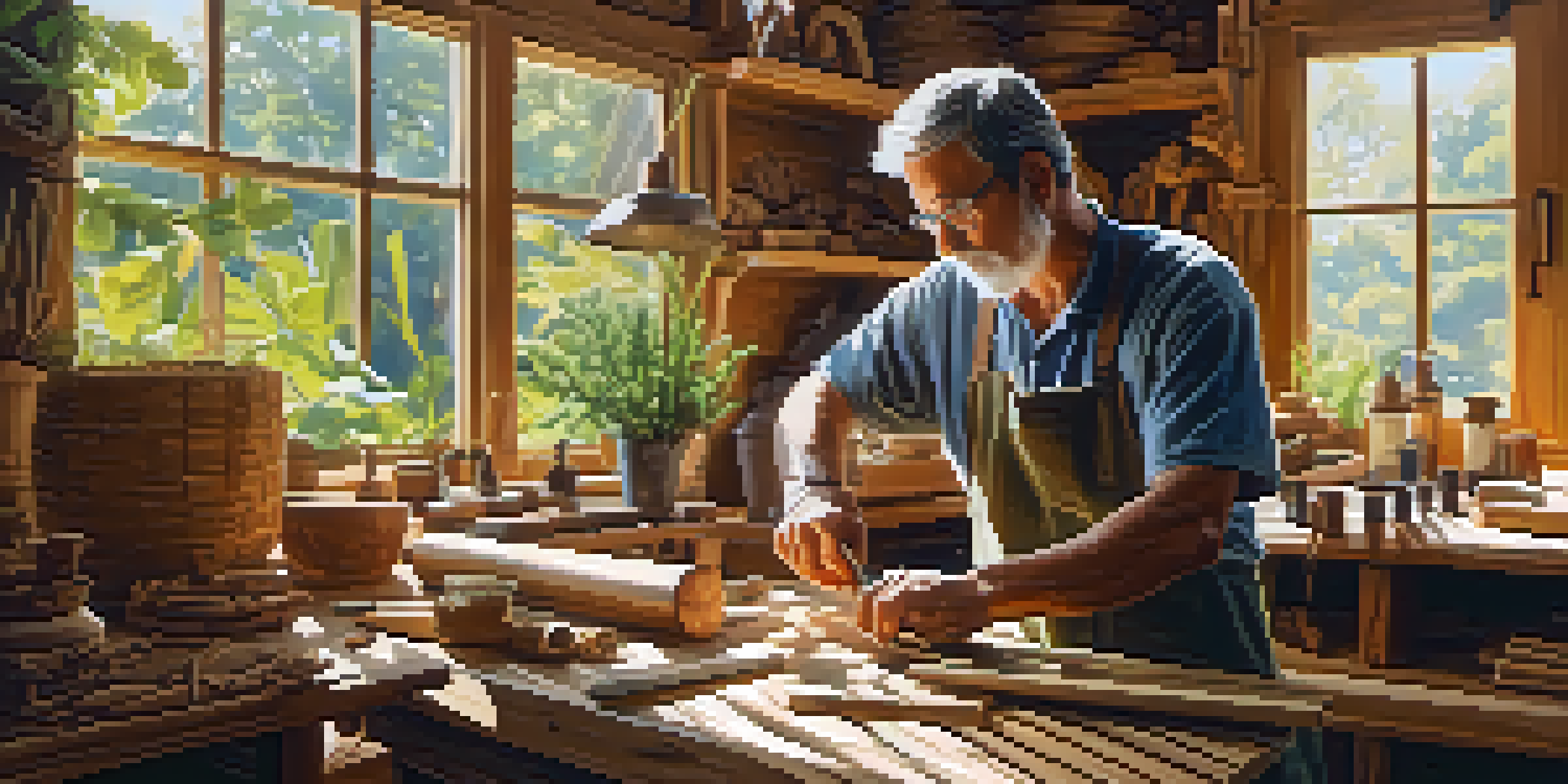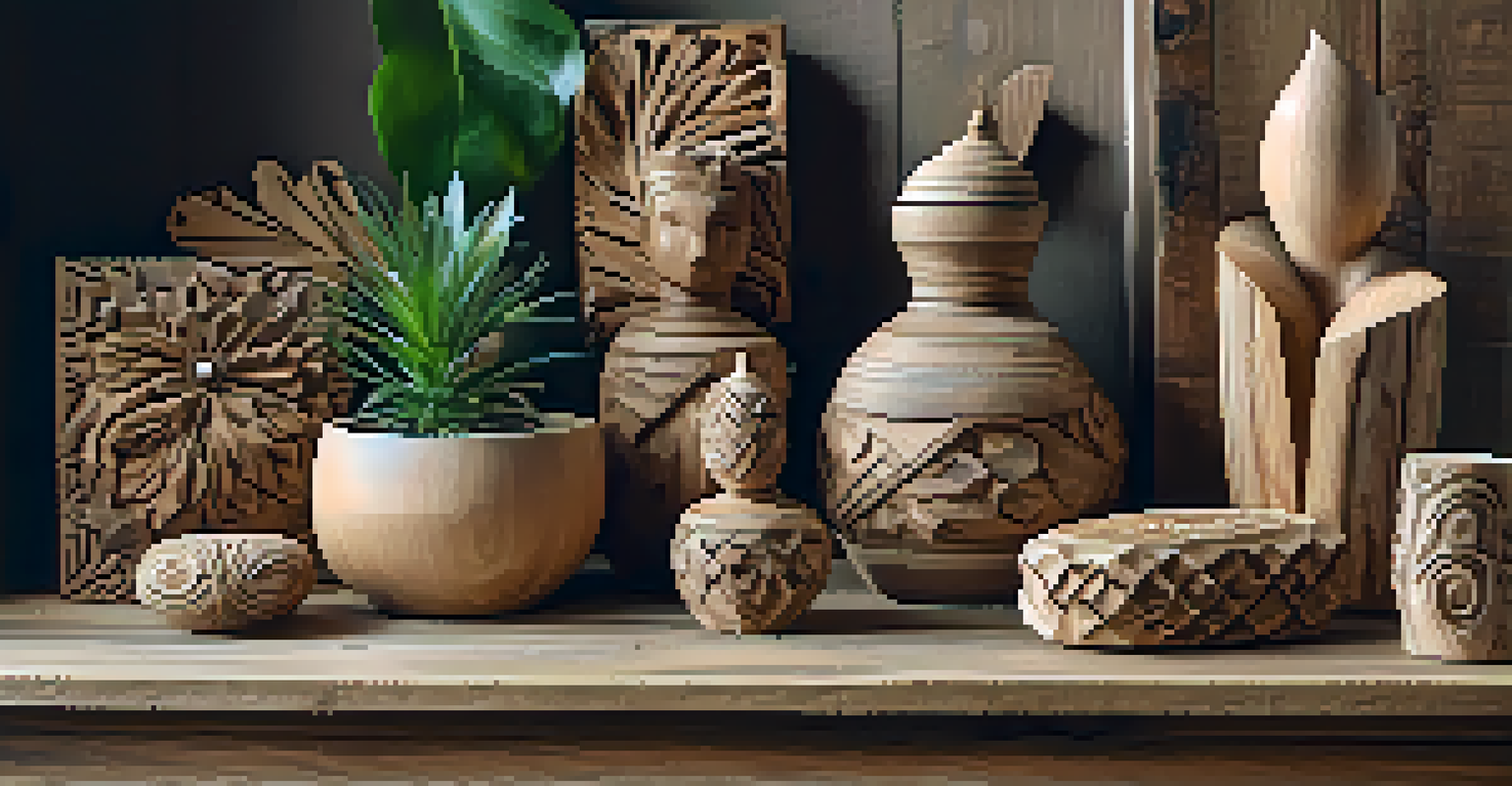The Importance of Eco-Friendly Practices in Wood Carving

Understanding Eco-Friendly Practices in Wood Carving
Eco-friendly practices in wood carving focus on sustainability and minimizing environmental impact. This involves using responsibly sourced wood, non-toxic finishes, and sustainable techniques. As consumers become more environmentally conscious, artisans must adapt to these practices to meet their customers' expectations. In essence, being eco-friendly is not just a trend; it's a vital responsibility.
The Earth does not belong to us. We belong to the Earth.
By choosing eco-friendly methods, wood carvers can contribute to the preservation of forests and biodiversity. Sustainable sourcing ensures that trees are harvested in a way that maintains ecosystem balance. For example, using reclaimed wood helps reduce waste and gives a second life to materials that might otherwise end up in a landfill. It's a win-win for both the artisan and the planet.
Moreover, understanding eco-friendly practices enhances the artisan's reputation. Customers are more likely to support businesses that prioritize sustainability. By promoting eco-friendly practices, wood carvers not only attract a loyal customer base but also inspire others in the industry to follow suit. This ripple effect can lead to significant positive change within the woodworking community.
The Benefits of Using Sustainably Sourced Wood
Sustainably sourced wood plays a crucial role in eco-friendly wood carving. It ensures that the materials used do not contribute to deforestation or habitat destruction. By selecting wood from well-managed forests, artisans can help maintain healthy ecosystems while still creating beautiful pieces. This not only benefits the environment but also supports local economies.

Additionally, using sustainably sourced wood can enhance the quality of the final product. Wood that is harvested responsibly is often more durable and better suited for intricate carving. For instance, species like bamboo or reclaimed hardwoods can provide unique aesthetics and robust characteristics. This leads to exceptional craftsmanship that can be appreciated for generations.
Eco-Friendly Practices Matter
Wood carvers adopting eco-friendly methods can enhance their reputation and contribute positively to the environment.
Choosing sustainably sourced wood also aligns with consumer values. As buyers become more aware of the environmental impact of their purchases, they actively seek out products made from ethical materials. By highlighting the use of sustainably sourced wood in marketing efforts, wood carvers can attract a segment of the market that prioritizes sustainability, ultimately benefiting both the artisan and the planet.
Non-Toxic Finishes: Protecting Health and Nature
Finishes are essential in wood carving, enhancing the beauty and longevity of the piece. However, many conventional finishes contain harmful chemicals that can affect both the artisan's health and the environment. By opting for non-toxic alternatives, wood carvers can create safer workspaces and contribute to cleaner air and water. This shift not only benefits the artisan but also protects the consumers who will enjoy their work.
Sustainability is not about doing less harm. It’s about doing more good.
Non-toxic finishes, such as plant-based oils and natural waxes, have gained popularity due to their eco-friendly properties. These finishes are not only safe but can also bring out the natural beauty of the wood. For example, using a natural oil finish can enhance the grain and texture without introducing harmful substances. This allows artisans to create stunning pieces that are also safe for families and the environment.
Moreover, incorporating non-toxic finishes can differentiate a wood carver's work in a competitive market. As more consumers seek out products that align with their values, offering eco-friendly options can become a key selling point. By promoting the use of non-toxic finishes, artisans can appeal to a growing audience that prioritizes health and sustainability.
The Role of Recycling and Upcycling in Wood Carving
Recycling and upcycling are powerful strategies in the realm of eco-friendly wood carving. By repurposing discarded wood, artisans can create new, unique pieces while minimizing waste. For instance, old furniture or pallets can be transformed into stunning carvings or functional art. This not only reduces the demand for new materials but also gives a second life to items that may have been forgotten.
Upcycling promotes creativity and innovation within the woodworking community. Artisans are challenged to think outside the box and discover potential in materials that others might overlook. This process can lead to the creation of distinctive pieces that tell a story, making them more appealing to consumers. A carved sculpture made from upcycled wood can carry a narrative that resonates with buyers who value sustainability.
Sustainable Wood Boosts Quality
Using sustainably sourced wood not only protects ecosystems but also enhances the durability and aesthetics of the final product.
Additionally, recycling and upcycling contribute to a circular economy, where materials are continuously reused rather than discarded. This approach not only reduces waste but also fosters a sense of community among artisans. By sharing ideas and techniques for upcycling, wood carvers can inspire one another to adopt more sustainable practices, ultimately leading to a positive shift within the industry.
Educating Customers on Eco-Friendly Choices
Educating customers about eco-friendly choices is essential for promoting sustainable practices in wood carving. By informing buyers about the benefits of sustainably sourced wood, non-toxic finishes, and recycling, artisans can empower them to make informed decisions. This education can take place through workshops, social media, or even product labels, showcasing the artisan's commitment to sustainability.
When customers understand the impact of their choices, they are more likely to support eco-friendly artisans. For example, sharing stories about the sourcing of materials or the processes involved can create a deeper connection between the artisan and the buyer. This transparency fosters trust and loyalty, encouraging consumers to prioritize sustainability in their purchasing decisions.
Furthermore, educating customers can spark broader conversations about sustainability within the community. As consumers advocate for eco-friendly practices in wood carving, they can influence other businesses to adopt similar approaches. This collective awareness can lead to a significant cultural shift towards sustainability, ultimately benefiting the environment and the woodworking industry as a whole.
The Economic Advantage of Eco-Friendly Practices
While sustainability is often viewed through an environmental lens, it also holds economic advantages for wood carvers. Eco-friendly practices can lead to cost savings in the long run, as sustainable materials often require less energy and resources to produce. For instance, using reclaimed wood eliminates the costs associated with new material sourcing, allowing artisans to maximize their profits.
Moreover, as consumers increasingly seek out sustainable products, the demand for eco-friendly wood carvings is on the rise. By positioning themselves as environmentally responsible artisans, wood carvers can tap into a growing market that prioritizes sustainability. This can lead to increased sales, customer loyalty, and a stronger brand reputation.
Educating for Sustainable Choices
By educating customers about eco-friendly options, artisans can foster loyalty and promote a broader culture of sustainability.
Additionally, businesses that embrace eco-friendly practices may qualify for grants or incentives aimed at promoting sustainability. By reducing waste and conserving resources, wood carvers can potentially access financial support that further enhances their operations. Ultimately, incorporating eco-friendly practices not only benefits the planet but also contributes to the financial success of the artisan.
Inspiring Future Generations of Wood Carvers
Inspiring future generations of wood carvers to adopt eco-friendly practices is vital for the longevity of the craft. By sharing knowledge and experiences, seasoned artisans can mentor younger woodworkers, instilling a passion for sustainability. This guidance can take the form of workshops, apprenticeships, or informal discussions, creating a supportive community that values eco-friendly methods.
As younger artisans enter the field, they bring fresh perspectives and innovative ideas that can further advance sustainability in wood carving. Encouraging them to explore sustainable materials and techniques can lead to exciting developments within the industry. For example, young woodworkers might experiment with new technologies that enhance eco-friendly practices, such as digital design tools or advanced finishing techniques.

Ultimately, the goal is to create a culture of sustainability within the woodworking community. By inspiring future generations to prioritize eco-friendly practices, artisans can ensure that the craft evolves in a way that respects both the environment and the art form. This commitment to sustainability will not only benefit the planet but also enrich the legacy of wood carving for years to come.